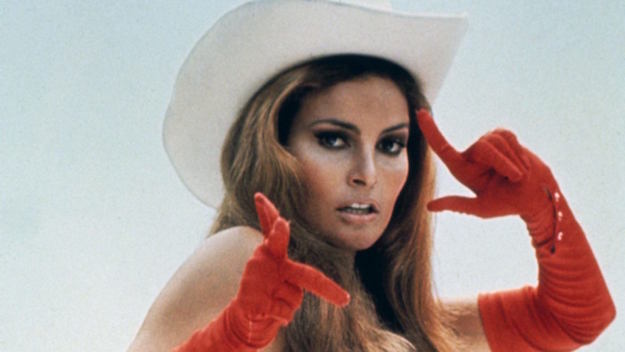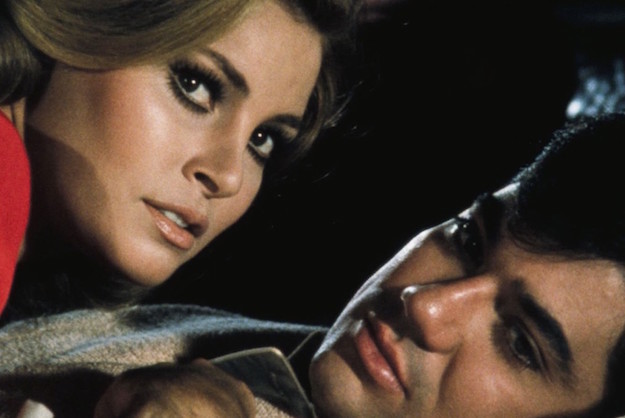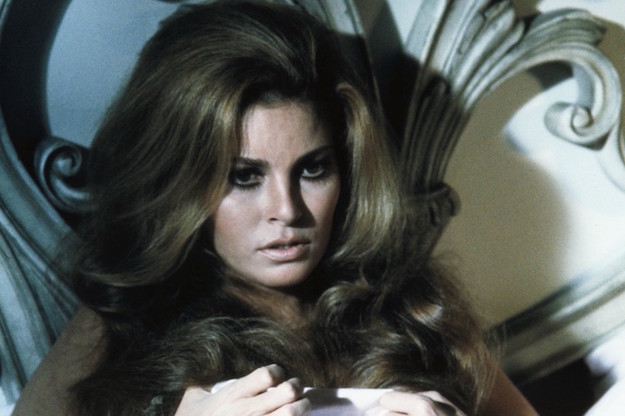Queer & Now & Then: 1970
In this biweekly column, I look back through a century of cinema for traces of queerness, whether in plain sight or under the surface. Read the introductory essay.

How is Myra Breckinridge, whose stated goal is “the destruction of the American male in all its particulars,” not more of a contemporary pop icon? Certainly the search-and-destroy protagonist of Gore Vidal’s controversial yet now widely respected 1968 novel Myra Breckinridge and of Michael Sarne’s notorious and still vilified 1970 movie adaptation, would seem to have some serious currency in a culture preoccupied with identifying and condemning toxic masculinity. But even more than that: a transgender woman whose mission is to infiltrate Hollywood and pull back the curtain to reveal that codes of maleness—and gender itself—are long-held social constructs rather than biological imperatives, Myra could rightfully be seen as a trailblazer of a sort. However, the movie incarnation of this singular character, as embodied by an undeniably committed Raquel Welch, is housed within an infamous flop so abrasive, antagonistic, and purposely alienating that it’s only nominally been recouped as a queer classic, let alone by the critical establishment at large.
This is not to say the film deserves to be reconsidered as some sort of misunderstood masterpiece (the film itself gives so little, what should it deserve in return at all?), especially on an aesthetic level, but that its status as merely an object of camp derision is perhaps unfair. Even a cursory peek at Myra Breckinridge reveals pleasures of such a gratifyingly perverse variety that one couldn’t outright dismiss it. How could this movie possibly have happened in the first place? Part of a new Hollywood intent on satiating a young audience allegedly hungry for something completely different, Twentieth Century Fox, under head Richard Zanuck, snatched up the film rights to Vidal’s book for $750,000, assigning it to the largely untested Sarne, a British actor turned director whose only prior film was Joanna (1968), a mysticism-tinged mod-London affair that would seem to have the requisite carefree sexuality and vanguard take on youth culture for Myra’s plunge into the outré. Yet as with so many eventual box-office disasters, the bad buzz started during production, with reports of on-set conflicts and cast dissatisfaction; the eventual glee critics and the public would take in denouncing the film as irredeemable garbage was only partly related to the quality of the bizarre final product.
Fox-contracted Welch, then best known as a pinup for her deerskin-bikini-clad appearance in One Million Years B.C.(1966) and for starring alongside Dudley Moore in Bedazzled (1967), would take her highest profile role yet as the post-op Myra, née Myron; and, in a casting coup that seems improbable today, catty film critic and celebrity profiler Rex Reed played Myron in fantasy sequences in which Myra converses (and sometimes dances) with her former male self, conceptual devices for the character’s internal monologue. Meanwhile the main supporting actors were shockingly illustrious: John Huston, in one of many late-career roles with which he willingly dissected the bluster and swagger of American masculinity (also including Chinatown and this year’s finally released The Other Side of the Wind), would growl from under a 20-gallon cowboy hat as her uncle, Buck Loner, owner of the Hollywood acting school where Myra ends up teaching and wreaking havoc; and none other than Mae West came out of retirement for her first screen appearance since 1943 as Leticia Van Allen, a man-hungry talent agent.

Outside Leticia’s office, emblazoned with the sign LEADING MEN ONLY, a male model introduces himself as “six feet, seven inches,” to which West responds without missing a beat, in her classic devil-may-care snicker, “Well, never mind about the six feet, let’s talk about the seven inches.” It’s both a parody and celebration of the pre-code star’s Hollywood persona, with the single-minded innuendo cranked up to absurd proportions. West’s casting speaks to the intended feminism of Vidal’s story about a woman ”whom no man will ever possess.” West is one of Hollywood’s emblems of female empowerment, a former vaudeville star whose characters’ unapologetic sexual appetites always put her in positions of power over her male costars, including, most famously, a young and beautiful Cary Grant in 1933’s She Done Him Wrong. (In Myra Breckinridge, a naïve, fresh-faced Tom Selleck is one of her boy toys.) In West’s presence, men were not merely bewitched; they became nearly subservient. Myra, meanwhile, intends to lay waste to the misogynist foundations of the movie dream factory by taking swaggering men down more than a few pegs. And since Myra Breckinridge came at a transitional moment for American studio moviemaking, on the precipice between the Golden Age and a New Hollywood ostensibly primed to tear down the old ways, the film functions as trenchant metatextual analysis in the guise of camp.
Scanning reviews of the period, one might notice that one of the most common words used to describe the film is “tasteless,” a term that’s intended as derisive, ignoring the possibility that its tastelessness is not only intentional but essential. In an era in which counterculture-minded studio hits such as Easy Rider, Five Easy Pieces, and M*A*S*H purported to buck the system by focusing on loners and outsiders, Myra Breckinridge had little time for matters of taste, and is the only one to blatantly ask, “What is normal?” Myra poses the question to the man who will become her targeted victim, wannabe movie stud Rusty Godowski (Tennessee-born Roger Herren), who, per an ironic Myra, is “the last stronghold of masculinity in this Disneyland of perversion.” The handsomest and dimmest of her Uncle Buck’s protégés, the athletically fit, gap-toothed Rusty makes it known that “faggots” make him sick and drawls charming phrases like “a man should act like a man” and “guys should ball chicks.” In opposing socially acceptable ways of being—and fucking—Myra Breckinridge couldn’t be any less interested in what the mainstream has dictated tasteful, and neither should Myra Breckinridge.
By laser-focusing on this meat-head hunk, Myra is able to both satiate her own lust and mete out punishment against an entrenched system that has long mistreated women, both physically and symbolically. Initially, she seems to just enjoy teasing Rusty, inviting him to her room during private office hours, critiquing his posture and making him dance to “Chattanooga Choo Choo.” Yet ultimately, in the story’s most daring gambit, and the one that contributed to the film’s eventual X-rating, Myra’s treatment of Rusty goes from mere objectification to humiliation and rape. That Myra’s nonconsensual “pegging” of a terrified Rusty, who’s strapped down to an examination table, ass out, is portrayed as both kink and comedy is the film’s final slap in the face to the audience, giving us license to snicker at the man’s degradation. (Unsurprisingly, Herren never acted again—what could be more career-killing for a man in Hollywood than to play a subjugated bottom?) Whether one finds this productive or simply grotesque perhaps says much about the tendency of the viewer, as well as his or her propensity for offense. Yet one cannot deny the intention is to offend, made all the more acute by Welch’s wearing a red-white-and-blue bikini and the decision to intercut the rape sequence (as is the case for much of the film) with clips from classic Hollywood films, raided from the Fox vault. In this way, scenes from Laurel and Hardy films, Shirley Temple’s Stowaway (1936), Busby Berkeley’s The Gang’s All Here (1943), Henry Hathaway’s Kiss of Death (1947), and others become decontextualized commentary on the action, a conceit that outraged more than a few viewers and even stars (Loretta Young successfully got her image out of the film by threatening to sue the studio).

Myra Breckinridge is shark-like in its single-minded pursuit of tearing down long-standing idols, and for that alone, is worthy of the label “subversive.” (Only Mae West remains untoppled from her perch, even getting a risqué celebratory number, “You Gotta Taste All the Fruit,” and a gorgeous succession of Edith Head–designed costumes.) Yet its unapologetic queerness is what truly compounds the film’s subversive nature. One wishes for a more precise, critical edge to its satire; in Vidal’s novel, Myra is influenced by the great queer critic Parker Tyler’s writings on Hollywood, and something of Tyler’s lacerating powers of wit and observation might have helped deepen the film’s surface inquiries. And there’s clearly nothing particularly sophisticated from today’s vantage point in its transgender politics, since the film uses Myra as a vessel for a metaphorical take on Hollywood gender assignment rather than a realist exploration of identity.
Yet Myra nevertheless remains a formidable figure of anarchic sexual liberation. A true test of how out-of-the-mainstream Sarne’s film was and remains, beyond its financial failure, is its persistence as an unwanted object. Situated on the edge of a revitalized Hollywood, the film promised new ways of thinking about how the studio system represented men and women. The unfortunate irony is that the New American Cinema of the much-vaunted 1970s, a period that Molly Haskell would call the “nadir” for roles for women, would be even more swaggeringly masculine than before. For the coming decades, the “degenerates” of Myra Breckinridge would have to go back into their closets.
Myra Breckinridge plays January 3 at the Quad Cinema as part of the series Rated X.
Michael Koresky is the Director of Editorial and Creative Strategy at Film Society of Lincoln Center; the co-founder and co-editor of Reverse Shot; a frequent contributor to The Criterion Collection; and the author of the book Terence Davies, published by University of Illinois Press.







